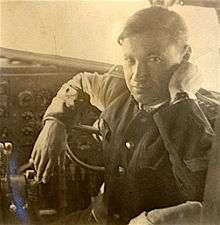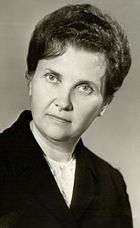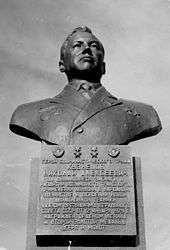Nikolai Alexeyevich Kuznetsov
| Nikolai Alexeyevich Kuznetsov | |
|---|---|
 | |
| Director of the Kazakh Soviet Socialist Republic Administration of Civil Aviation | |
| Personal details | |
| Born |
19 December 1922 Baytugan, Kazakhstan |
| Died |
12 August 2009 (aged 86) Alma-ata, Kazakhstan |
| Nationality | Russian |
| Spouse(s) | Antonina Kuznetsova |
| Profession | Aviator |
| Awards |
|
| Military service | |
| Service/branch | Soviet Armed Forces |
| Years of service | 1941–1947 |
| Commands | Soviet Air Forces |
| Battles/wars | World War II |
Nikolai Alexeyevich Kuznetsov (19 December 1922 —12 August 2009) was a Russian aviator. He served in the Soviet Armed Forces from 1941-47.
Early life
Nikolai Alexeyevich Kuznetsov (Russian: Николай Алексеевич Кузнецов) was born on December 19, 1922 in the village of Baytugan, Nurinskiy district, Karaganda region of the Kazakh Soviet Socialist Republic. His father, Alexey, died when Nikolai was thirteen. Nikolay had to work hard to help his mother Alexandra with the sowing, harvesting, courtship of livestock, and caring for the rest of the family. His younger siblings are Anna, Maria, Marina, Katerina, Olga and Grigoriy. At the same time he studied well in high school. In one of his interviews with the newspaper "Evening Almaty", he said:
My family - simple rural workers formed my views, outlook, based on love and desire to work. All that stays with me through all my life. My parents taught me – You must work hard. Nothing in this life is given for granted. To achieve something you need to put all of yourself, you must put all your soul into it.
World War II

Since the beginning of World War II, Kuzntetsov served in the army. He graduated from the military school Selischenskaya as a pilot. From the beginning Nikolay was known as a manager and a teacher who had a high level of professionalism, and remarkable aviator skills. In 1943 Nikolay was appointed as an pilot-instructor in the Kurgan pilots flying school, where he was in charge of flight crews preparation for an active front-line activities. He did complete a number of dangerous strategic tasks, and participated in war battles. One such job was taken place in the city of Magnitogorsk. The mission was a combat operation to eliminate Otto Skorzeny, and his division of Hitler’s army. The enemy’s plan was to destroy a steel factory, which produced weapons for the Soviet Union army, the largest at the time. The Skorzeny’s attempt failed because of the Soviet counterintelligence actions. Red Army units were able to destroy Nazi plans. Nikolay’s real war assignment mission was a success. After completion of his military service in 1947, he became a pilot in the Akmolinsk airport in Kazakh Soviet Socialist Republic. A year later he was promoted to the director of the airport.
Career
In 1963 Nikolay Kuznetsov was sent to the department of the Kazakh civil aviation in the position of deputy chief of the flight services. Seven years later in 1970 he became director of the department. Work experience in the Department of Civil Aviation of Kazakhstan was proof of his true human qualities, indomitable will, impeccable knowledge of the industry, and the ability to correctly assess the present and look to the future. One of the most essential and important his qualities was the ability to work with people and achieve high results.
In his new position he had to face many problems and overcome bureaucratic hurdles. The Civil Aviation of Kazakhstan had a great development and a powerful qualitative leap forward during the time of his management. It became one of the most advanced sectors of the Kazakh economy, which was equipped with advanced aviation technology. By the early 1980s more than one hundred thousand kilometers of air lines were opened in Kazakhstan. The capital of Kazakh SSR Alma-Ata was linked to all the capitals of Soviet republics. Also, Alma-ata was linked with all regional centers of Kazakhstan and various major cities and resort areas of the Soviet Union. More than fifty percent of Kazakhstan's population each year used these air transport services of Aeroflot Soviet Airlines. Up to fifteen million hectares of farmland were served by agricultural special airplanes. Seventeen airports were built during this time, as well as ten airports having their own hotels. Even in small villages of Kazakhstan people were able to purchase airflight tickets to any point of destination of the Soviet Union. The appearance of a new airplanes for civil and cargo usage such as models An-24, An-26, An-30, Il-18, Il-62, Il-86, Tu-134, Tu-154, Yak-40, Mi-2, and Mi-8 required the presence of highly qualified crew, engineering, and dispatch teams. All pilots of large airplanes had higher education. One out of every seventh employee of the technical aviation base had engineering degree. Under Kuznetsov’s leadership many professional aviators were trained, as well as flight operators, and other aviation related professionals. The Academy of Civil Aviation was founded in Alma-Ata. At the same time the Flight School was founded in Aktobe. The Ministry of Civil Aviation of the USSR founded a flight operations school in Burunday village. With the development of new aircraft in Domodedovo and Sheremetyevo airports in Moscow the flight personnel of Kazakhstan were predominantly selected.
Social Activity
Nikolay Kuznetsov faced the collapse of the USSR during his retirement. He had become an eyewitness to the destruction of the country and the severance of ties with other countries. During those years of crisis the aviation sector was affected greatly. Despite the unstable economic situation and uncertain future of the former Soviet Union, Kuznetsov with other talented organizers managed to create an airline Sayakhat. Kuznetsov was chairman of the company, and a member of board of directors. During this time he was elected as a member of the government nonprofit civil aviation veteran organization. In addition he was a member of the Advisory Board of the Department of Transportation of Kazakhstan. Also he was involved in multiple social activities. He gave lectures in different Universities of Kazakhstan. His lectures included patriotism and passion of Kazakhstan. Throughout his life Nikolay was always cheerful and optimistic, as well as full of creative ideas and initiatives. For his family, friends and colleagues, Kuznetsov was always reliable for support and help. Life of Nikolay Alexeyevich Kuznetsov was a true example of courage, selflessness, and a great service to his country.
Family

Antonina Dmitievna Kuznetsova (August 28, 1924 – November 25, 2008) was married to Nikolay Kuzentsov for over fifty years. Her family name is Bedanov. She was born in the Stavropol region of Russia. In her early childhood she moved with her parents, and two younger sisters to Baku, Azerbaijan. She graduated from the Medical Institute of Baku with a physician degree. In the 1940s she was sent to work in Akmolinsk, Kazakhstan as a general physician. There she met her future life partner and husband Nikolay. She continued her medical studies in Alma-ata where she became an OB/GYN doctor. Antonina and Nikolay settled in Alma-ata to raise two daughters, a grandson and two granddaughters.
Awards

- Twice Hero of Socialist Labour
- Two Orders of Lenin
- Order of the Red Banner of Labour
- Medal "Veteran of Labour"
A bronze monument in his homeland by the Presidium of the Supreme Soviet. In the 1980s Kuznetsov was awarded the Council of Ministers of USSR, and he was elected as a deputy of the Supreme Soviet of the Kazakh Soviet Socialist Republic.
Books
"Helm and Course" - is the autobiographical book featuring the names of over three hundred people, such as Dinmukhamed Konayev, Leonid Brezhnev, Mikhail Gorbachev, Air Marshal Bugaev, and many others.
References
- Elena Brusilovskaya (January 18, 2013). "Life given to the Sky". Kazakhstanskaya Pravda. Retrieved 2013-01-22.
- Galina Galkina (December 20, 2002). "Kuznetsov's standard". New Generation. Retrieved 2010-03-15.
- Ivan Krutov (January 29, 1999). "Helm and Course of Professional". Kazakhstanskaya Pravda. Retrieved 2010-03-15.